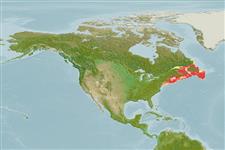Environment: milieu / climate zone / depth range / distribution range
Écologie
marin démersal; profondeur 1 - 110 m (Ref. 5951). Temperate; 55°N - 39°N, 75°W - 49°W
Western Atlantic: southern Labrador in Canada to New Jersey in USA.
Taille / Poids / Âge
Maturity: Lm ? range ? - ? cm
Max length : 97.0 cm TL mâle / non sexé; (Ref. 49746)
Burrows in soft muddy bottoms from shallow water to 110 m depth. Feeds mainly on benthic infauna found in and around its burrow system; its prey consisting of various amphipods, polychaetes, shrimp and small fish (Ref. 87300).
Life cycle and mating behavior
Maturities | Reproduction | Spawnings | Egg(s) | Fecundities | Larves
Robins, C.R. and G.C. Ray, 1986. A field guide to Atlantic coast fishes of North America. Houghton Mifflin Company, Boston, U.S.A. 354 p. (Ref. 7251)
Statut dans la liste rouge de l'IUCN (Ref. 130435)
Menace pour l'homme
Harmless
Utilisations par l'homme
Outils
Articles particuliers
Télécharger en XML
Sources Internet
Estimates based on models
Preferred temperature (Ref.
123201): 0.9 - 12.2, mean 6.4 °C (based on 135 cells).
Phylogenetic diversity index (Ref.
82804): PD
50 = 0.6250 [Uniqueness, from 0.5 = low to 2.0 = high].
Bayesian length-weight: a=0.00102 (0.00046 - 0.00225), b=3.06 (2.88 - 3.24), in cm total length, based on all LWR estimates for this body shape (Ref.
93245).
Niveau trophique (Ref.
69278): 3.0 ±0.1 se; based on size and trophs of closest relatives
Fishing Vulnerability (Ref.
59153): High vulnerability (59 of 100).
Nutrients (Ref.
124155): Calcium = 34.6 [19.4, 59.2] mg/100g; Iron = 0.37 [0.21, 0.62] mg/100g; Protein = 18.3 [17.4, 19.2] %; Omega3 = 0.338 [0.186, 0.601] g/100g; Selenium = 23 [12, 46] μg/100g; VitaminA = 5.31 [1.53, 18.73] μg/100g; Zinc = 0.523 [0.373, 0.732] mg/100g (wet weight);
